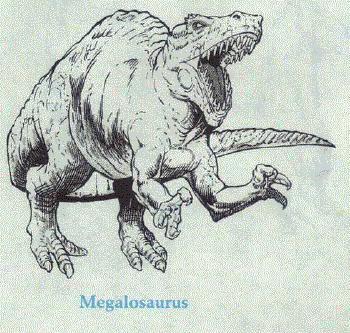| Dilophosaurus | Dinichthys | Mamenchisaurus | Massospondylus | Megalosaurus | Ornitholestes | |
|---|---|---|---|---|---|---|
| Climate/Terrain: | Any land | Any ocean | Any swamp | Any land | Any land | Any plain |
| Frequency: | Rare | Common | Uncommon | Uncommon | Uncommon | Rare |
| Organization: | Solitary, pack | Solitary | Solitary | Herd | Solitary | Pack |
| Activity Cycle: | Day | Day | Day | Day | Day | Day |
| Diet: | Carnivore | Carnivore | Herbivore | Herbivore | Carnivore | Carnivore |
| Intelligence: | Non- (0) | Non- (0) | Non- (0) | Non- (0) | Non- (0) | Non- (0) |
| Treasure: | Nil | Nil | Nil | Nil | Nil | Nil |
| Alignment: | Nil | Nil | Nil | Nil | Nil | Nil |
| No. Appearing: | 1-3 | 1-4 | 1-6 | 4-16 | 1-2 | 2-12 |
| Armor Class: | 5 | 7 | 7 | 5 | 5 | 4 |
| Movement: | 18 ( +1 jump) | 21 | 6 | 15 | 12 | 24 |
| Hit Dice: | 8+2 | 10 | 18 | 7 | 12 | 2 |
| THAC0: | 13 | 11 | 5 | 13 | 9 | 19 |
| No. of Attacks: | 3 | 1 | 1 | 1 | 3 | 1 |
| Damage/Attack: | 2-12/2-12/1-6 | 5-20 | 2-16 | 3-12 | 1-3/1-3/3-18 | 2-8 |
| Special Attacks: | Nil | Swallow | See below | Nil | Nil | Trample |
| Special Defenses: | Nil | Nil | Nil | Nil | Nil | See below |
| Magic Resistance: | Nil | Nil | Nil | Nil | Nil | Nil |
| Size: | H (20' long) | H (25' + long) | G (70' long) | H (18' + ) | H (30' long) | M (6½' tall) |
| Morale: | Average (10) | Steady (11) | Steady (12) | Average (10) | Steady (11) | Average (10) |
| XP Value: | 1,400 | 4,000 | 10,000 | 420 | 2,000 | 35 |
Dilophosaurus
The weak skull of this monster prevents strong jaw muscle attachments, so it uses its taloned hind feet, especially its spurs, to inflict horrible wounds on its prey, while its snaky neck strikes to deliver biting damage. It prefers open areas to jungle, and seldom ventures into areas thick with trees. Dilophosaurus often hunts with one or more of its kind, seeking a large dinosaur to kill for a feast.
One other unusual feature of this carnosaur is its pair of head crests, which only males of the species have.
Dinichthys
Dinichthys's name-"terrible fish" - reveals that this fearsome creature is not actually a dinosaur but a huge, primitive fish. Its great mouth can swallow man-sized prey on a natural attack roll of 20.
Mamenchisaurus
The mamenchisaurus is another sauropod, like the brontosaurus and diplodocus, but much longer and much lighter. This swamp dwelling herbivore uses its 35-foot-long neck-fully half of its ungainly length-to browse the foliage at the very top of nearly any tree it chooses, simply by standing up on its back legs and reaching for it.
Sages who study such things claim that the mamenchisaurus has the longest neck of any naturally occurring creature, but it pays for this extra length. The 19 neck vertebrae of the mamenchisaurus are held together by bony struts, so the immense creature cannot bend its neck except at the head and slightly at the shoulders.
The mamenchisaurus strikes only in defense, but if it accidentally steps on some small creature (such as a human), it inflicts 3d8 points of damage.
Massospondylus
Another common dinosaur, this seemingly peaceful herbivore is well equipped with long, sharp teeth for defensive biting. lf attacked- a common occurrence, for the beast is a favorite of such carnosaurs as tyrannosaurus, deinonychus, and allosaurus-the massospondylus delivers swift bites and then runs away.
While this dinosaur's front claws look like formidable weapons, with five long fingers and a sharp spike on the thumb, the massospondylus uses these hands onJy to gather vegetable material for food. like the camarasaurus, the massospondylus swallows stones to help grind the food that it eats.
The massospondylus is stupid, and any approach by strange creatures might be interpreted as an attack.
 Megalosaurus
Megalosaurus
The megalosaurus is another carnosaur, like the allosaurus and tyrannosaurus, but is smaller - 30 feet long, ten feet tall, and weighing only one ton. While it is as able as its larger cousins of functioning bipedaJly, the megalosaurus often travels on all fours.
The megalosaurus eats sauropods, like the mamenchisaurus above, principally using its large jaws and teeth to bring down any unsuspecting victim. The claws of the megalosaurus, while sharp, are capable of causing only incidentaJ damage to such giants as the diplodocus and brachiosaurus.
Ornitholestes
This exceptionally fast carnivore roams the plains hunting small prey, from insects and eggs to creatures its own size. Although quite light in weight, it is difficult to strike an ornitholestes because of its speed. Packs of ornitholestes have been known to attack larger creatures if the dinosaurs significantly outnumber their victims and they are sufficiently hungry.
